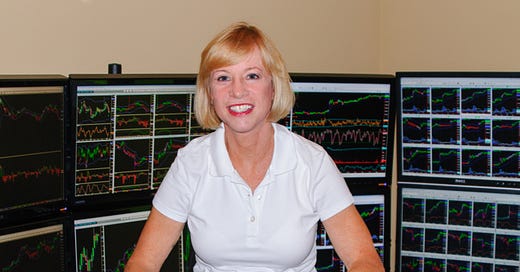Linda Bradford Raschke's journey in trading reads like a masterclass in passion, resilience, and pattern recognition. Her story is not only inspiring but also deeply instructive for traders at any level. Here's a deep dive into the principles, experiences, and philosophies that shaped one of the finest short-term traders of our time.
Early Fascination and Entry into Trading
Raschke's exposure to the markets began at home, assisting her father, an avid but unsuccessful trader, by reviewing hundreds of stock charts in search of specific patterns. This early engagement sparked her fascination with price behavior and technical analysis.
In college, she participated in a unique program managing a donor-funded trust. While decisions were based primarily on fundamentals, the excitement of real-world trading ignited her passion further.
Post-graduation, Linda faced rejection from every brokerage firm she applied to. Determined to stay connected to the markets, she visited the Pacific Coast Stock Exchange every morning before work. Her dedication caught the attention of a seasoned options trader, who mentored and backed her with a $25,000 stake, setting up a 50/50 profit-sharing partnership.
First Catastrophe and Resilience
Initially, Raschke achieved strong profits by exploiting inefficiencies in the early 1980s options markets. However, a poorly timed trade during a Cities Service takeover announcement wiped out her gains and left her $30,000 in debt.
Despite this heavy setback, she maintained perspective by observing others who suffered even larger losses yet recovered. She quickly secured another backer and rebuilt her trading career, internalizing the critical lesson that survival and mental toughness are paramount in trading.
Transition to Independent Trading
In 1986, a horseback riding accident forced Raschke to leave the trading floor due to physical injuries. Trading from an office, she discovered she could leverage quote machines, indicators, and a quieter environment to enhance her trading performance.
Her transition was seamless—in fact, her first year off the floor was her most profitable ever, highlighting her adaptability and analytical strength.
The Raschke Trading Style
Linda Raschke developed a highly specialized approach centered on short-term market patterns:
Short-Term Focus: Most trades last between two and ten days, with an ideal mindset of holding for only two to three days to maintain flexibility.
Direction, Not Magnitude: Raschke focuses solely on forecasting price direction rather than setting specific profit targets.
Precision in Entry: Great entries "buy time," allowing for quick assessment with minimal risk.
Rubber Band Effect: Market extremes often result in sharp reversals, a core principle of her contrarian trading setups.
Indicators: Tick readings, TRIN, and premium/discounts between futures and cash prices form her primary technical toolkit, but interpretation always remains intuitive and adaptive.
Example: During the infamous October 1987 crash, Raschke seized the moment, methodically buying S&P futures contracts as fear peaked. Despite initially facing a six-figure drawdown, her understanding of market psychology and valuations allowed her to profit as markets stabilized.
Lessons from Mistakes
Raschke openly discusses her trading errors:
Premature Entries: A chronic issue early on, addressed through deliberate patience—sometimes counting to ten before entering a trade.
Neglecting Small Positions: She learned to respect all positions equally to avoid unexpected large losses.
Overtrading: Attempting to follow too many markets diluted focus and profitability.
Her mantra: recognize mistakes quickly, correct immediately, and minimize damage.
The Music of the Markets
Linda's years of piano practice (hours daily from age 5 to 21) developed extraordinary pattern recognition and discipline—skills that directly translated to her trading prowess. She views both music and markets as structures of repeating patterns with variations.
Musical Analogies: Price consolidations mirror quiet interludes; market breakouts echo musical crescendos.
Performance Philosophy: Just as perfection in playing a piece is impossible, perfect trades are rare. The goal is consistent improvement, not flawlessness.
Advice to Aspiring Traders
Raschke's advice for beginners is practical and demanding:
Immerse Fully: Dedicate yourself completely to the trading craft.
Specialize First: Master one market or pattern before expanding.
Manual Market Readings: Jot down prices every five minutes for a week to internalize support, resistance, and flow.
Actively Engage: Build your own routines for market "readings" instead of passively consuming data.
Independent Thinking: Trust your own work; if you need external validation on a trade, it's time to exit.
Accept Mistakes: They are inevitable. Swift correction is essential.
Conclusion: Confidence, Craft, and Consistency
Linda Bradford Raschke exemplifies that exceptional trading is not about luck or innate genius but about treating trading as a craft—one requiring passion, daily practice, humility, and iron-willed self-reliance.
Her ability to consistently recognize short-term patterns, combined with disciplined execution and resilient psychology, sets her apart. Her belief that short-term price movements can be predicted—in contrast to long-term randomness—forces a reevaluation of common assumptions about market behavior.
Ultimately, Raschke's philosophy transcends trading: it's about striving for continuous mastery, embracing uncertainty with confidence, and maintaining grace under pressure.
In her words, "There's no better satisfaction than playing a piece well, whether the instrument is a piano or the markets."






Wow. So well written.
It keeps in mind, "Whatever is, is possible"